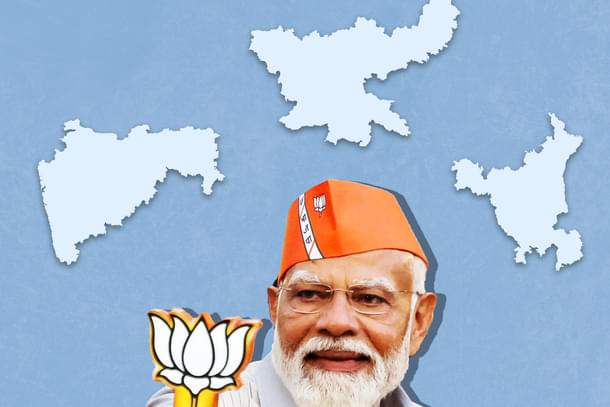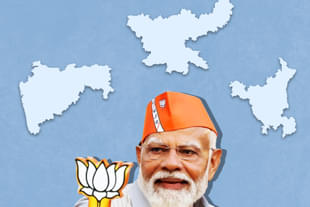Politics
Six Months, Three State Elections: The Plank Test For Modi 3.0 Is Right Around The Corner
Abhishek Kumar
Jun 10, 2024, 02:36 PM | Updated Jun 14, 2024, 05:57 PM IST
Save & read from anywhere!
Bookmark stories for easy access on any device or the Swarajya app.


The surprise outcome of the 2024 general elections (GEs) has disrupted many equations. The National Democratic Alliance (NDA), which many projected to win 380-400 seats, struggled to reach even 300.
The Bharatiya Janata Party (BJP), the backbone of the alliance, also lost 63 seats.
This negative momentum poses a serious legitimacy crisis for both the BJP and the NDA. The next six months are crucial for both, as three crucial state assembly elections (AEs) will serve as a litmus test for the Modi 3.0 government.
Haryana Elections
By virtue of being close to Delhi, Haryana’s importance increases manifold for the NDA. The state has 10 Lok Sabha and 90 Vidhan Sabha seats. The BJP won all 10 seats and 40 seats in the 2019 GE and AE respectively. It later entered into a post-poll alliance with the Jannayak Janata Party (JJP) to form the state government.
Manohar Lal Khattar and JJP president Dushyant Chautala were sworn in as chief minister and deputy chief minister, respectively. This was the second consecutive chief ministerial term for Khattar.
However, the government proved to be unpopular.
Khattar’s emphasis on digitisation did not bode well for the masses. Delays in formalisation projects excluded many government beneficiaries, leading the opposition to deride the government as ‘Portal Ki Sarkar’.
Khattar’s pacifist response to Nuh violence worsened the situation.
The BJP also has to combat the perception that it has become anti-Jat. The removal of Om Prakash Dhankar, a Jat, and the appointment of Nayab Singh Saini, an OBC (Other Backward Class), as his replacement exemplify this perception.
Additionally, farmers’ and wrestlers' protests, in which Jats participated in large numbers, have exacerbated tensions. Teachers, health workers, and other government servants have also protested regularly.
Amidst this anti-incumbency, the party believed that removing the chief minister would help. Khattar was asked to contest the GE while Nayab Singh Saini took over as chief minister.
Concurrently, the BJP used this opportunity to sever ties with the JJP, and Saini took the oath with support from his party and independent members of the legislative assembly (MLAs).
The change of leadership doesn't seem to have helped. The BJP’s seat share halved in the GE, and its vote share declined from 58 per cent in the 2019 GE to 46 per cent.
Meanwhile, Congress's vote share increased from 28.5 per cent to 43.67 per cent. Congress swept the Jat heartland, confirming fears about Jats’ discontent with the BJP.
In May, three independent MLAs withdrew their support from the government, while two JJP MLAs came out in support of the BJP in June amidst calls for a floor test.
Maharashtra Elections
While the BJP was able to run its government for two consecutive terms in Haryana, the party has struggled to do so in Maharashtra.
Maharashtra is a difficult state for politics. No other party had been able to win more than 100 seats in this state for a very long time. BJP managed this feat not once but twice. In 2014, it won 122 seats by itself and in 2019 it won 105 seats in an alliance with the undivided Shiv Sena of the past.
While BJP was able to form a government in 2014, but it couldn't come to power in 2019 because the Shiv Sena ditched the BJP after the results and joined the Congress-Nationalist Congress Party (NCP) camp to get a better bargain, with Uddhav Thackeray becoming chief minister.
Finally in 2022, BJP was able to form a government once again after Eknath Shinde wrested control of the Shiv Sena from Uddhav Thackeray and joined the BJP-led coalition. Thackeray then had to form a new party now known as Shiv Sena (Uddhav Balasaheb Thackeray).
Similar was the case with the NCP with Ajit Pawar wresting control of the party from his uncle Sharad Pawar in 2023, joining the BJP-Sena coalition government and the latter then forming a new party of his own named NCP (Sharadchandra Pawar).
However, if the 2024 GE results are any indication, the road for the BJP-led NDA looks tough in the AE as well. The BJP won only nine seats, down from its 2019 tally of 23, while its coalition partners, the Eknath Shinde-led Shiv Sena and Ajit Pawar-led NCP, could muster only seven seats and one seat respectively.
The NDA in Maharashtra is currently facing crises on multiple fronts.
Firstly, Devendra Fadnavis, its key face in the state, has been vilified by the opposition, and there is not much visible effort to counter this . The ongoing Maratha caste agitation leader Manoj Jarange has publicly called him enemy of the Marathas despite Fadnavis led government having been the first to fulfill the socio-politically dominant caste's demand for reservation in 2018. This reservation was quashed later during the Maha Vikas Aghadi government's tenure by the Supreme Court in 2021.
Secondly, the NDA’s hold on Vidarbha, Marathwada, and Northern Maharashtra has witnessed a steep decline, with the alliance losing 12 seats in these regions.
Thirdly, the party's cadre itself is unhappy with the candidates being fielded by the NDA, citing anti-incumbency and nepotism as dominating themes in the state.
Fourthly, the BJP’s decision to ally with breakaway factions of Shiv Sena and NCP did not yield desirable results, as the Sharad Pawar-led NCP and Uddhav Thackeray-led Shiv Sena bagged more seats than their rival factions.
The fight for 288 seats in the Maharashtra assembly is going to be tougher for the NDA than in 2019 and 2014.
Jharkhand Elections
The results of the 2024 GE in Jharkhand can only be called satisfactory for the BJP-led NDA. Though the coalition of BJP and All Jharkhand Students Union Party (AJSUP) won nine seats, it is three less than the 2019 figure.
This continues the negative momentum the BJP experienced after losing the 2019 AE. The main reason for that loss was the inability of Raghubar Das, then Jharkhand chief minister, to capitalise on his government's achievements.
Das’s government was largely portrayed as anti-tribal by the opposition Jharkhand Mukti Morcha (JMM). JMM, the largest party in the Jharkhand faction of the then United Progressive Alliance (UPA), won 30 seats while the BJP had to contend with 25.
Learning from this, the BJP did some course correction by making Babulal Marandi, a tribal, its state unit chief. Draupadi Murmu, a tribal BJP leader from Jharkhand, being appointed as India’s President was also supposed to bring laurels for the party. Besides that, multiple schemes were laid down for tribals, and Birsa Munda was accorded extraordinary respect.
However, the silence on the different religious identity (Sarna religion) for tribals and the arrest of chief minister Hemant Soren on corruption charges were not taken kindly by tribals. The BJP lost all five seats reserved for Scheduled Tribes (STs) in the state.
To add to the injury, Jairam Mahato, with his new agenda — Jharkhand for Jharkhandis, has emerged as the third front for the upcoming AE. Mahato can snatch the Kurmi vote bank of the NDA (10-12 per cent) and is also ideologically closer to the JMM.
For the NDA, registering victory in these elections is vital. Currently, the opposition is claiming that the BJP winning 240 seats is a sign of decline and that the trend will continue in future elections. On the other hand, it is being said that local factors played a key role in this debacle, rather than overarching themes against the party and alliance.
The party has to rely on the coalition to form a government. Coalition governments, by their very nature, can slow down decision-making processes and reform agendas in the country.
NDA, especially the BJP, performing well in these elections will strengthen the party's hand in the coalition government at the Centre.
(With inputs from Krishna Dange)
Abhishek is Staff Writer at Swarajya.





